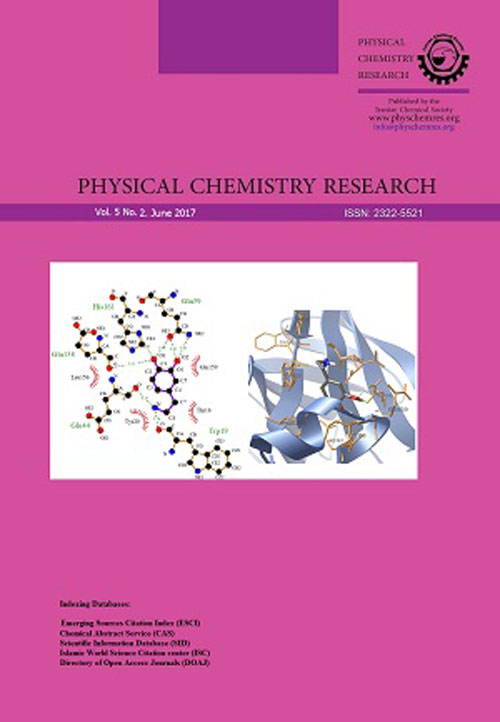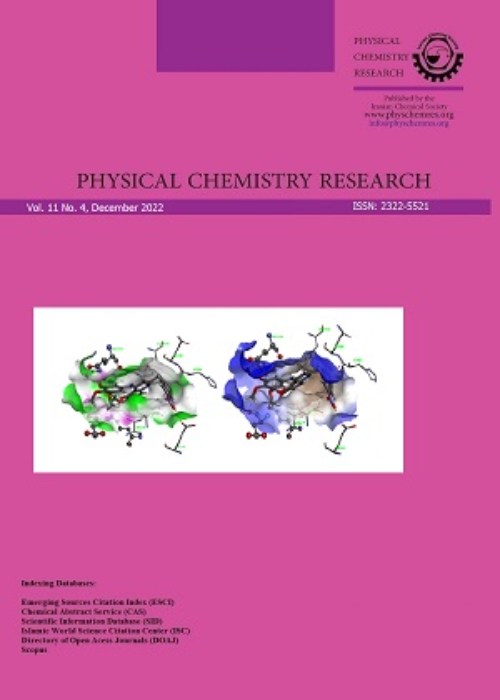فهرست مطالب

Physical Chemistry Research
Volume:3 Issue: 2, Spring 2015
- تاریخ انتشار: 1393/11/28
- تعداد عناوین: 7
-
-
Pages 89-98Magnesium oxide nanoclusters have attracted much attention due to their potential applications to catalysis and novel optoelectronic materials. In the present study, we have studied the electronic and magnetic properties of the stoichiometric magnesium oxide nanoclusters (MgO)n for n = 2-20. Although the binding energy increases with the size of the cluster, it reaches the asymptotic limit of about 66.0 eV per unit for relatively large n value. The static dipole polarizability also exhibits distinct size dependence, reflecting clearly the structural transition when the cluster grows. The polarizability and the binding energy of the clusters are found to be inversely related to each other and their correlation is rationalized by invoking the minimum polarizability principle. Moreover, principle of maximum hardness is also used to characterize the magic number clusters. A well-defined linear correlation is found between static dipole polarizability and the inverse of ionization potential. The most important feature of this work is the NMR study of MgO clusters which is reported for the first time. For each cluster size, the calculated NMR parameters at 17O nuclei together with electronic and structural data provide detailed insight into the properties of bulk and in particular of nanosized structures. Variation of 17O chemical shieldings demonstrates the electrostatic environment divisions around the oxygen nuclei which in turn originate from the cluster structure and its symmetry.Keywords: MgO nanoclusters, Chemical shielding, NMR, MPP, PMH
-
Pages 99-110In this work, Mg-doped ZnO nanostructures were prepared in water under ultrasonic irradiation for 60 min without using any organic compounds or post preparation treatments. The prepared samples were characterized by X-ray diffraction (XRD), scanning electron microscopy (SEM), transmission electron microscopy (TEM), energy dispersive analysis of X-ray (EDX), diffuse reflectance spectroscopy (DRS), and Fourier transform-infrared (FT-IR) techniques. Powder XRD patterns display that ZnO has wurtzite hexagonal crystalline phase and loading of Mg2 ions does not change its crystalline phase. The SEM and TEM images represented that morphology of Mg-doped ZnO nanostructures remarkably is different from the undoped one. Photocatalytic activities of the samples were investigated by degradation of methylene blue under UV irradiation. The degradation rate constant on Mg-doped ZnO nanostructures increases nearly 2.5-fold relative to the undoped one. Influence of various operational parameters, such as ultrasonic irradiation time, calcination temperature, and pH of the solution on the degradation activity was investigated and the results discussed. Finally, the results showed that the holes and hydroxide radicals are the main species in degradation of the pollutant.Keywords: Mg-doped ZnO, Ultrasonic irradiation, Photocatalysis, Nanostructures
-
Pages 111-123Vanadium phosphorus oxides (VPO) has been applied as a heterogeneous catalyst in gas phase oxidation reactions and its application is very limited in liquid phase. In this study a series of cobalt-doped vanadium phosphorus oxides (VPO-Co) catalysts with different loading of Co (0.01-1.0 mol ratio of Co/V) were prepared. Oxidation of benzyl alcohol was studied in the liquid phase over VPO and VPO-Co catalysts, using tert-butylhydroperoxide (TBHP) as an oxidant. These samples were characterized by XRD, SEM and Fouriertransform infrared (FT-IR) techniques. The optimal design of experiments using Box-Behnken method was employed to evaluate the effects of individual process variables (, 0, 1, levels) such as, reaction temperature (30, 60 and 90 °C), reaction time (30, 255 and 480 min) and molar ratio of Co/V (0, 0.5 and 1) and their optimum values were found to be 89.86 °C, 477.8 min and 0.64 molar ratio Co/V, respectively, to achieve a conversion of 65.44%.Keywords: VPO catalyst, Co-promoter, Optimization, Benzyl alcohol, Response surface methodology
-
Pages 125-143This study aims to design some dual-target anticancer candidates, capable to act as an alkylating agent as well as a thymidylate synthase (TS) inhibitor. The designed scaffold is a combination of nucleobase, amino acid and aziridine structures. The candidates are docked into TS and three DNA double strand structures and evaluated based on their binding interaction energies and ligand efficiencies, compared to several reference drugs. The ADME properties of the alkylating agents are also predicted. The designed ligands exhibit improved interaction energies and lower ligand efficiencies with respect to the reference drugs. Among the ligands, L4 is the best DNA binding agent and L2, L5 and L6 are the best TS inhibitors. In addition, the thioTEPA based Ser and Met analogues are the strongest and poorest alkylating agents, respectively. Further, molecular dynamics simulations on the best ligand-target complexes, i.e. L4-4AWL and L6-TS systems, provide evidences for the potential L6 and L4 anti-proliferation activities.Keywords: Dual-target, Anticancer, DNA, Thymidylate synthase, Molecular simulation
-
Pages 145-154In this paper, the thermodynamic properties of the aqueous mixed electrolyte system containing 1-butyl-3-methylimidazolium chloride ([BMIm]Cl) and NaCl are reported based on the potentiometric method. The potentiometric measurements were performed on the galvanic cells without liquid junction of the type:Ag-AgCl [BMIm]Cl (m1), NaCl(m2), H2O│IL-ISE, over total ionic strengths from 0.0025 to 2.000 mol kg-1 for different series of salt molal ratios r (r = m[BMIm]Cl/mNaCl = 0.2, 1.0, 2.5, 5.0) and pure [BMIm]Cl in aqeous system at T = 298.2 K. The PVC based [BMIm]-selective electrode (IL-ISE) and Ag-AgCl electrode used in this work were prepared in our laboratory. The experimental results were analyzed with the Harned rule and Pitzer model. The Harned coefficients and the Pitzer mixing interaction parameters (θ[BMIm]Na, ψ[BMIm]NaCl) were evaluated under investigation system. The results show the under-studied system obeys the Harned rule. Furthermore, the obtained parameters by the Pitzer model were used to calculate the values of the mean activity coefficients of NaCl, the osmotic coefficients, the solvent activity, and the excess Gibbs free energies for the whole series of the studied mixed electrolyte systems.Keywords: activity coefficient, Potentiometric measurements, [BMIm]Cl, NaCl, Pitzer model
-
Pages 155-167We present detailed theoretical studies of the H-bonded complexes formed from interaction between 5-fluorouracil and various six-membered cyclic nitrosamine compounds. In this study, an investigation on intermolecular interactions in X-NU (X = CH2, SiH2,BH, AlH, NH, PH, O and S) complexes is carried out using density functional theory. The calculations are conducted on B3LYP/6-311þþG** level of theory for optimization of geometries of complexes and monomers. Furthermore, quantum theory of Atoms in Molecules (AIM) and natural bond orbital (NBO) method are applied to analyze the H-bond interactions in respective complexes. The electron density (ρ) and Laplacian (s2ρ) properties, estimated by AIM calculations, indicate that O H bonds possess low ρ and positive s2ρ values which are in agreement with electrostatic character of the H-bonds. In addition, the examination of the H-bond in these complexes by quantum theory of NBO method supports the obtained results. Natural population analysis data, electron density, and Laplacian properties, as well as, the ʋ(C-H) and ʋ(N-H) frequencies of complexes, calculated at the B3LYP/6-311þþG** level of theory, are used to evaluate the H-bond interactions. Several correlations between topological, geometrical and energetic parameters are also found.Keywords: Interaction energy, Intermolecular hydrogen bonding, aim, NBO
-
Pages 169-178In recent years there has been a great deal of attention paid by researchers in investigating ionic liquids (ILs) mainly due to the tremendous potential that ionic liquids have in reaction and separation technology. Sonic speed is an important thermodynamic property of ionic liquids (ILs) and always chosen as a source to determine other properties. A database for the sonic speed of pure ILs created by collecting experimental data from literature covering the period from 2005 to 2013 is presented. In this study, based on sonic speed experimental data, for the first time the relationship between boiling temperature, reduced temperature and pressure for 2198 data of 29 ionic liquids covering wide ranges of temperature, pressure, and sonic speed has been examined. In results, a 6-parameter model with ability for predicts the sonic speed of ionic liquids is presented. The obtained model has an average absolute relative deviation (AARD%) of 1.30%,a determination coefficient (R2) of 0.987, and a root mean square error (RSMD) of 1.85.Keywords: Ionic liquid, Sonic speed, Correlation, Estimation


